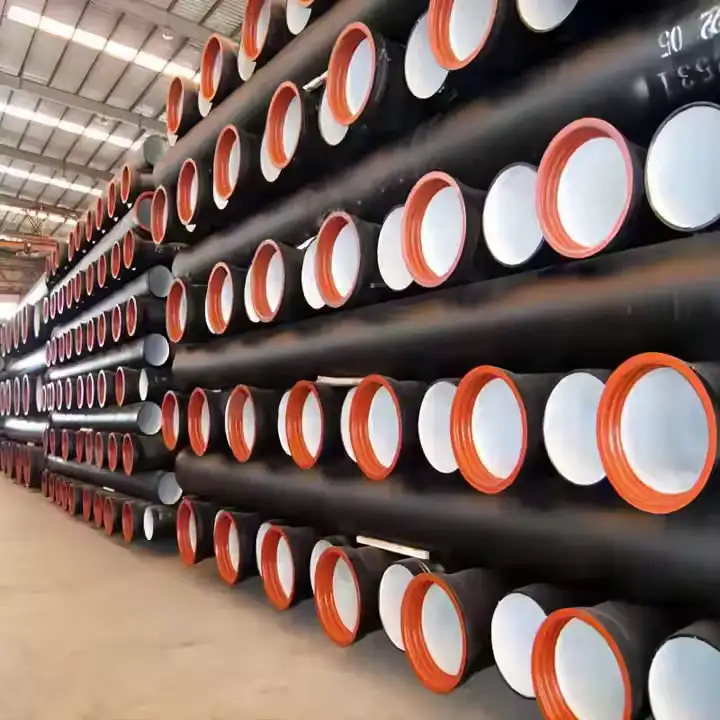When selecting piping materials for infrastructure, industrial, or construction applications, ductile iron and steel pipes are two widely used options, each offering distinct advantages. Ductile iron, known for its exceptional strength, flexibility, and corrosion resistance, is often favored in water and wastewater systems due to its durability under pressure and cost-effectiveness. Steel pipes, on the other hand, boast high tensile strength and versatility, making them ideal for high-pressure environments, oil and gas transportation, and structural projects.

Material Introduction
Ductile Iron Pipe
Ductile iron pipe is produced by centrifugal casting of ductile (nodular) cast iron, characterized by spheroidal graphite inclusions that provide high tensile strength and impact resistance.
Pipes are typically lined internally with cement mortar and coated externally with asphaltic or zinc coatings, with loose polyethylene sleeving (LPS) used in highly corrosive soils.
Steel Pipe
Steel pipe used for fluid conveyance is commonly made of carbon steel (e.g., ASTM A53/A53M), available in welded (ERW, SAW) or seamless forms.
Sizes follow the Nominal Pipe Size (NPS) system, with wall thickness designated by Schedule (e.g., Sch. 40), and specialty casing pipe often specified under ASTM A139 or A252 for structural applications.
Pros and Cons
Ductile Iron Pipe
Pros
-
Safety Factor & Durability: DI design uses a safety factor of 2.0, compared to 1.33–2.0 for steel, resulting in thicker walls and greater long‑term reliability.
-
Corrosion Control: Native oxide layer plus field‑applied polyethylene encasement (e.g., V‑Bio®) provides robust protection in varied soils without costly bonded coatings.
-
Energy Savings: Larger inside diameters lead to lower pumping costs—on average a 21% reduction in energy expenses versus comparable steel lines.
-
Longevity: Engineered for a 100+‑year service life under proper installation and protection practices.
Cons
-
Higher Initial Cost: Typical market price is around $30.75/ft for a 6″ CL350 DI line (≈$100.85/m) versus $10.25/ft ($33.62/m) for comparable steel, varying by diameter.
-
Weight & Handling: Heavier sections (18–20 ft joints) require more handling effort and bedding support.
-
Corrosion in Aggressive Soils: Without proper LPS, DI pipes may experience graphitization or pitting, shortening lifespan to 21–40 years in “uniquely severe” environments.
Steel Pipe
Pros
-
Lower Up‑Front Cost: Welded or seamless carbon steel can be 30–60% cheaper per meter than DI, depending on size and finish.
-
Long Joints & Lightweight: Typical 40–50 ft sections reduce joint count; lighter weight eases transport and installation.
-
High Strength‑to‑Weight: Certain grades deliver equivalent yield strength with thinner walls.
Cons
-
Corrosion Protection Required: Must use bonded coatings (cement mortar, tape‑wrap) and often cathodic protection—both prone to damage and expensive maintenance.
-
Shorter Lifespan: Galvanized steel averages 20–50 years; low‑carbon steel around 50 years under optimal maintenance.
-
Higher Pumping Costs: Smaller inside diameters and rougher internal surfaces increase friction losses and energy use.
Price Comparison
| Diameter (Nominal) | Ductile Iron (CL350) | Carbon Steel (Sch. 40) |
|---|---|---|
| 6″ (150 mm) | $30.75/ft ≈$100.85/m |
– |
| 12″ (300 mm) | – | $10.25/ft ≈$33.62/m |
Note: Prices vary by region, coating, and volume.
Lifespan
-
Ductile Iron: > 100 years under benign soils; > 50 years even in aggressive soils with proper LPS protection.
-
Steel: 20–50 years for galvanized; up to ~50 years for maintained low‑carbon steel.
International Standards
Ductile Iron Pipe
-
ANSI/AWWA C151/A21.51 – Centrifugally cast DI pipe design.
-
AWWA C150‑14 – Thickness design guidelines.
-
ISO 9349:2017 – Pre‑insulated DI pipes & joints.
-
ISO 2531 (FDIS) – DI pipes, fittings and joints for water.
Steel Pipe
-
ASTM A53/A53M – Carbon steel black & hot‑dip galvanized, welded & seamless.
-
ISO 4200:1991 – Plain end steel tubes, general dimensions & masses.
-
ISO 23.040.10 Series – Iron & steel pipes for water & sewage.
Applications
-
Ductile Iron: Water transmission/distribution, wastewater, subaqueous crossings, trenchless installations (HDD), seismic zones, bridge crossings.
-
Steel: Water/gas transmission, structural casing, chilled water systems, oil & chemical pipelines, high‑pressure service.
FAQ
-
Which is better for long‑term water mains?
DI is preferred for low life‑cycle cost and energy savings; steel may be chosen for specialty high‑pressure or gas applications. -
Can DI handle very high pressures?
Yes—DI Class 350 can handle up to 350 psi working pressure with design safety margins. -
Is steel pipe recyclable?
Steel is highly recyclable, but requires de‑coating and energy‑intensive re‑melting. DI recycling retains up to 95% of material quality. -
How does cold weather affect installation?
DI can be installed in all weather conditions; steel welding is sensitive to moisture and low temperatures. -
What about joint flexibility?
DI push‑on joints allow deflection (0–5°), reducing fittings; steel butt‑welded joints are rigid and require precise alignment。
Case Studies
Ductile Iron: Wildfire Resilience
A May 3, 2022 test in Birmingham, AL showed DI pipe maintained structural integrity under wildfire temperatures, highlighting its resilience in disasters.
Ductile Iron: Corrsion in Aggressive Soil
A 35‑year‑old DI main in corrosive soil developed leaks beyond repair, underscoring the need for polyethylene sleeving or coatings in harsh environments。
Steel: Buckling in Hard Rock Jacking
A 2024 MDPI study analyzed circumferential and hoop strains in steel pipes jacked through hard rock, providing guidelines to mitigate buckling deformation.
Steel: Live Leak Repair
In Malaysia, a 300 mm steel pipe live leak at 6 bar was effectively sealed on‑line using composite repair wraps, avoiding shutdowns.
References:
- ANSI/AWWA C151/A21.51 – Ductile-Iron Pipe, Centrifugally Cast, for Water
- ASTM A53/A53M – Standard Specification for Pipe, Steel, Black and Hot-Dipped, Zinc-Coated, Welded and Seamless
- ISO 2531:2009 – Ductile Iron Pipes, Fittings, Accessories and Their Joints for Water Applications
- Wikipedia – Ductile Iron Pipe: Structure, Properties and Applications
- MDPI Applied Sciences (2024) – Buckling Performance of Steel Pipes in Hard Rock Jacking Construction

